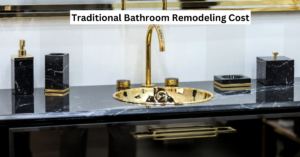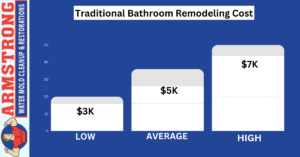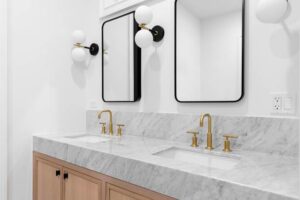
Thinking about upgrading your bathroom? Discover the true cost of traditional remodeling!
The cost of a traditional bathroom remodel can vary widely depending on several factors, such as the size of the space, materials used, and the extent of the changes you want to make. On average, homeowners can expect to spend anywhere from $10,000 to $20,000 for a full remodel. This typically includes updates to flooring, plumbing fixtures, cabinetry, and tiling, along with labor costs.
| Cost Category | Price Range (USD) |
| Low Cost | $3,000 |
| Average Cost | $5,000 |
| High Cost | $7,000 |

Traditional bathroom remodels: Worth the investment or too costly? Let’s break it down!
| Type of Remodel | Cost Range (USD) | Description |
| Basic Remodel | $3,000 – $8,000 | Includes minor updates such as new fixtures, fresh paint, and basic tile replacement. |
| Mid-Range Remodel | $8,000 – $15,000 | Upgrades like new flooring, bathtub replacement, modern vanities, and upgraded plumbing. |
| Luxury Remodel | $15,000 – $30,000+ | High-end materials, custom cabinetry, smart bathroom technology, and premium fixtures. |
| Full Bathroom Renovation | $10,000 – $25,000 | Includes layout changes, new plumbing, electrical updates, and full fixture replacements. |
| DIY Remodel | $2,000 – $7,000 | Homeowner-led projects with cost-saving methods like refinishing rather than replacing. |
| Aging-in-Place Remodel | $5,000 – $20,000 | Includes walk-in tubs, grab bars, non-slip flooring, and wider doorways for accessibility. |
Introduction
A traditional bathroom remodeling cost varies depending on factors such as size, materials, labor, and additional upgrades. Whether you’re planning a minor refresh or a full renovation, understanding the costs involved will help you set a realistic budget. This guide breaks down the expenses associated with a traditional bathroom remodel to help you make informed decisions.
Factors Affecting Traditional Bathroom Remodeling Cost
Size of the Bathroom
The cost of traditional bathroom remodeling largely depends on the size. A small guest bathroom will require fewer materials and labor, whereas a master bath remodel can be more expensive.
Materials & Fixtures
The choice of tiles, vanities, countertops, and fixtures significantly influences costs. High-end materials like marble or custom cabinetry will increase expenses, while budget-friendly alternatives can help you save.
Labor Costs
Hiring contractors, plumbers, electricians, and designers adds to the overall budget. Labor rates vary by region, experience, and project complexity.
Plumbing & Electrical Work
Older homes often require upgraded plumbing and electrical systems, which can increase costs. Moving fixtures like sinks and toilets will also require additional plumbing expenses.
Permits & Regulations
Depending on your location, you may need permits for plumbing, electrical, and structural changes. Factor in permit costs when budgeting for your remodel.
Major Cost Components in a Remodel
Flooring & Walls
Ceramic tiles, vinyl, or stone flooring range in price, with ceramic being more budget-friendly and marble adding to the cost.
Vanities & Countertops
Vanities vary in price based on material and design, with quartz and granite being popular choices for countertops.
Bathtubs & Showers
Upgrading to a modern bathtub or a walk-in shower can increase costs. Features like rain showers and glass enclosures add elegance but also increase expenses.
Toilets & Sinks
From basic models to smart toilets with bidet functions, the price range varies. Undermount or vessel sinks also influence the overall cost.
Lighting & Ventilation
Proper lighting and ventilation prevent mold growth and enhance aesthetics. LED lighting and exhaust fans are popular choices.
Hidden Costs & Unexpected Expenses
During renovations, you may encounter hidden issues that add to the budget:
- Structural Issues – Rotting wood, outdated plumbing, or weak walls may need repair.
- Mold & Water Damage – Addressing leaks and mold can add significant costs.
- Upgrading Outdated Plumbing – Old pipes may need replacement to comply with current codes.
Ways to Reduce Traditional Bathroom Remodeling Cost
DIY vs. Hiring Professionals
While DIY renovations can save money, hiring professionals ensures quality and compliance with building codes.
Choosing Cost-Effective Materials
Opting for ceramic tiles instead of marble, or laminate countertops instead of quartz, can help reduce costs while maintaining style.
Reusing Existing Fixtures
If possible, refinishing bathtubs and repainting cabinets instead of replacing them can save thousands of dollars.
Comparing Traditional vs. Eco-Friendly Bathroom Remodeling Costs
Cost Differences
Eco-friendly bathroom remodeling costs may be higher initially but offer long-term savings through water-efficient fixtures and energy-saving lighting.
Long-Term Savings & Benefits
Low-flow toilets, LED lights, and sustainable materials reduce utility bills and are environmentally friendly.
Cost-Saving Tips for Traditional Bathroom Remodeling
Choose Cost-Effective Materials
Opting for alternatives like ceramic tiles instead of natural stone can help save money.
Consider DIY Where Possible
If you have the skills, handling minor tasks like painting and demolition can reduce labor costs.
Reuse Existing Fixtures
Refinishing bathtubs and cabinets instead of replacing them can significantly lower expenses.
Plan the Remodel in Phases
Spreading out the project over time can help manage costs more efficiently.
Traditional Bathroom Remodeling Cost vs other types of bathroom remodeling services
| Type of Remodel | Cost Range |
| Modern Bathroom Remodeling Cost | $10,000 – $50,000 |
| Contemporary Bathroom Remodeling Cost | $12,000 – $55,000 |
| Eco-Friendly Bathroom Remodeling Cost | $12,000 – $45,000 |
| Coastal Bathroom Remodeling Cost | $30,000 – $75,000 |
| Industrial Bathroom Remodeling Cost | $15,000 – $60,000 |
| Farmhouse Bathroom Remodeling Cost | $10,000 – $40,000 |
| Luxury Spa Bathroom Remodeling Cost | $25,000 – $100,000 |
| Small Bathroom Remodeling Cost | $5,000 – $15,000 |
| Traditional Bathroom Remodeling Cost | $8,000 – $3,000 |
Summary

A traditional bathroom remodel is an investment that can enhance both the functionality and aesthetics of your home. While the cost can range from a few thousand dollars for minor updates to over $30,000 for a high-end renovation, understanding the key cost factors allows for better budgeting and decision-making. The size of the bathroom, choice of materials, labor costs, and any necessary plumbing or electrical upgrades all play a significant role in the final price.
If you are looking to save money, there are several ways to reduce expenses without compromising quality. Opting for budget-friendly materials, refinishing existing fixtures, and handling some DIY tasks can help keep costs down.
However, for complex tasks such as plumbing and electrical work, hiring professionals ensures safety and compliance with building codes.
Beyond the financial aspect, a well-planned bathroom remodel can significantly improve your daily comfort, add value to your home, and even increase energy efficiency with eco-friendly fixtures.
Whether you are aiming for a simple refresh or a complete transformation, careful planning, thorough research, and a realistic budget will help you achieve the best results.
FAQs
Typically between $10,000 and $20,000, depending on materials and labor.
Reuse fixtures, choose budget materials, and DIY minor tasks.
On average, 2 to 6 weeks.
Yes, for plumbing, electrical, or structural changes.
Yes, with DIY work and minimal upgrades.
